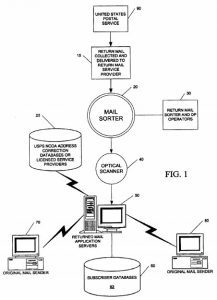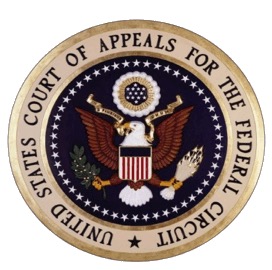On Monday, August 28th, the U.S. Court of Appeals for the Federal Circuit issued a decision in Return Mail, Inc. v. United States Postal Services (USPS), which affirmed a finding of patent invalidity stemming from a December 2015 decision by the Patent Trial and Appeal Board (PTAB). Although not an issue discussed in the Federal Circuit decision, there is some question as to whether this particular covered business method (CBM) review was properly limited to financial service business method patents in light of at least one previous decision by a different Federal Circuit judicial panel, which overturned an invalidity finding for improper institution of a CBM.
 The Federal Circuit’s decision affirms findings of patent-ineligible subject matter found in U.S. Patent No. 6826548, titled System and Method for Processing Returned Mail. Issued in November 2004, it claimed a method for processing a plurality of undeliverable mail items by encoding data including intended recipient ID info on mail items prior to mailing, receiving mail items returned as undeliverable, scanning and decoding the encoded information to identify intended recipients having incorrect addresses and electronically transferring information for the identified intended recipients to update the mailer’s sending address files. The resulting invention addressed historical problems with manual handling of undelivered mail in a quick and accurate way for a much lower cost.
The Federal Circuit’s decision affirms findings of patent-ineligible subject matter found in U.S. Patent No. 6826548, titled System and Method for Processing Returned Mail. Issued in November 2004, it claimed a method for processing a plurality of undeliverable mail items by encoding data including intended recipient ID info on mail items prior to mailing, receiving mail items returned as undeliverable, scanning and decoding the encoded information to identify intended recipients having incorrect addresses and electronically transferring information for the identified intended recipients to update the mailer’s sending address files. The resulting invention addressed historical problems with manual handling of undelivered mail in a quick and accurate way for a much lower cost.
In February 2011, Return Mail filed a patent infringement suit against the United States in the U.S. Court of Federal Claims. Return Mail asserted the ‘548 patent against the U.S. after years of licensing negotiations between Return Mail and the USPS going back to 2003. Return Mail alleged that USPS executives had instructed the firm to develop a pilot program to show how the technology can handle returned and undeliverable mail for high-volume mailers. By the spring of 2006, USPS announced that it would be unveiling an address change service (ACS) known as OneCode, a system designed to process undeliverable mail with the use of an intelligent mail barcode. In August 2006, executives from Return Mail met with the VP of product development at USPS to present information on the ‘548 patent and how the OneCode system infringed the patent, but the USPS refused to license.
The recent CBM trial decided at the PTAB was not the first time that the USPS attempted to have the ‘548 patent invalidated. In late January 2007, the USPS filed a third-party request with the U.S. Patent and Trademark Office to initiate an ex parte reexamination of the ‘548 patent. The reexamination was instituted and, as a result, the USPTO eliminated all 38 original claims and added to the ‘548 patent nearly 25 new claims which were determined as patentable based on prior art. The reexamination certificate for the amended ‘548 patent was issued in January 2011.
Although Return Mail’s case in federal claims court had progressed to the state of claim construction, a stay in that case was ordered in July 2014 after the USPS had filed a petition for a patent review challenge trial at the PTAB. The USPS filed a petition for CBM review on the ‘548 patent in April of that year, charging that claim 39 of the ‘548 patent was eligible for CBM review. Claim 39 of the reexamined ‘548 patent reads:
“A method for processing returned mail items sent by a sender to an intended recipient, the method comprising: decoding, subsequent to mailing of the returned mail items, information indicating whether the sender wants a corrected address to be provided for the intended recipient, on at least one of the returned mail items; obtaining an updated address of the intended recipient subsequent to determining that the sender wants a corrected address to be provided for the intended recipient; and electronically transmitting an updated address of the intended recipient to a transferee, wherein the transferee is a return mail service provider.”
The USPS contended that claim 39 was eligible for CBM review covered the “practice, administration, and management” of financial services, adding that the ‘548 patent’s Class 705 classification strongly suggested that it was a CBM patent and cites a quote from Sen. Chuck Schumer (D-NY) from the legislative history of the America Invents Act (AIA) of 2011 which suggests a broader scope for CBM review than simply patents covering a financial product or service. The USPS also alleged that the patent’s specification, which discusses “business mail” sent in high-volumes by “insurance companies, mortgage and finance companies,” also classified the ‘548 patent as a covered business method. A panel of administrative patent judges (APJs) at the PTAB voted to institute the CBM review in October 2014.
In October 2015, the PTAB issued a final written decision concluding the CBM review, finding that claims 39 through 44 of the reexamined ‘548 patent were directed at unpatentable subject matter. “We recognize that the legislative history of the AIA has ‘competing statements from various legislators with regard to the possible scope of [these] issues,” the final written decision reads just before citing Sen. Schumer’s quote regarding the broader scope which could be applied to CBM patent determinations. The APJ panel was persuaded by USPS’s validity challenge under 35 U.S.C. § 101 under the standard set out by the U.S. Supreme Court’s 2014 decision in Alice Corporation v. CLS Bank International. Further, the APJs were not persuaded by Return Mail’s arguments that the claims satisfied the machine and transformation test, finding that the claims did not recite an “optical scanner” or an “application server” and were merely directed at conventional and generic hardware which existed before the ‘548 patent was filed.
Although the main question decided by the Federal Circuit in upholding the PTAB’s invalidity findings surrounded the issue of standing and the definition of the U.S. government as a “person,” it’s interesting to note that this case may reflect a philosophical split which may have formed within the 18 judges serving that court. Last November, a different judicial panel at the Federal Circuit headed by Circuit Judge Jimmie Reyna issued a decision in Unwired Planet v. Google which overturned PTAB findings of patent invalidity because the Federal Circuit panel found that the CBM review in that case was improperly instituted. As Judge Reyna wrote in the majority opinion he authored:
“The patent for a novel lightbulb that is found to work particularly well in bank vaults does not become a CBM patent because of its incidental or complementary use in banks. Likewise, it cannot be the case that a patent covering a method and corresponding apparatuses becomes a CBM patent because its practice could involve a potential sale of a good or service.”
So it appears that there’s a faction within the Federal Circuit which supports a limited scope for CBM review and another faction willing to much more broadly interpret the statute, and find more patents to be CBM patents. Perhaps a petition for an en banc rehearing on that issue could render some interesting results, assuming the Federal Circuit would not consider the issue waived.

![[IPWatchdog Logo]](https://ipwatchdog.com/wp-content/themes/IPWatchdog%20-%202023/assets/images/temp/logo-small@2x.png)


![[Advertisement]](https://ipwatchdog.com/wp-content/uploads/2024/04/Patent-Litigation-Masters-2024-sidebar-early-bird-ends-Apr-21-last-chance-700x500-1.jpg)

![[Advertisement]](https://ipwatchdog.com/wp-content/uploads/2021/12/WEBINAR-336-x-280-px.png)
![[Advertisement]](https://ipwatchdog.com/wp-content/uploads/2021/12/2021-Patent-Practice-on-Demand-recorded-Feb-2021-336-x-280.jpg)
![[Advertisement]](https://ipwatchdog.com/wp-content/uploads/2021/12/Ad-4-The-Invent-Patent-System™.png)







Join the Discussion
5 comments so far.
Anon
August 31, 2017 01:14 pmThanks Gene,
As I read your reply, the voice of Lewis Carroll’s Humpty Dumpty echoed: it is a rule when I say it is a rule***
The CAFC has been forced to learn from the Supreme Court for too long.
It is time to do BOTH:
1) have Congress employ their Constitutional power of jurisdiction stripping and remove the non-original jurisdiction of patent cases from the Supreme Court,
AND
2) create a new (and untainted) Article III specialty court that will fulfill the original mandate that Congress had when the CAFC was first created.
*** the exchange, if I recall correctly:
“When I use a word,” Humpty Dumpty said, in rather a scornful tone, “it means just what I choose it to mean – neither more nor less.”
“The question is,” said Alice, “whether you can make words mean so many different things.”
Gene Quinn
August 31, 2017 12:12 pmAnon-
You say: “Last I recall, CAFC panels are not at liberty to decide cases differently than a previous panel that set the notion of first instance.”
That is the Federal Circuit rule, but it seems to only be honored in the breach. Only in the very rare circumstance does a panel ever feel compelled to follow that rule, or even mention it.
The CAFC does whatever they want. While the Supreme Court doesn’t get patents on any level, it is easy to understand their disgust with the Court as a whole.
Anon
August 31, 2017 11:34 amvg- that heightened interest started well before Prost took the reins.
Just saying.
Valuationguy
August 31, 2017 09:41 am<>
When the Chief Judge is the one who disagrees with the prior panel’s precedence…she doesn’t give a fart about precedence.
Just another example of why those who follow the rules (Reyna’s panel) will typically be pushed aside by those who don’t (Prost/Dyk/Wallach) in an environment of low (to no) supervision. Ever wonder why the SCOTUS is paying more attention to patent cases in the past several years since Prost became Chief Justice? The Supreme Court used to accept only around 2 patent/trademark-type cases per year….and I think had 5 or 6 last year and another 3 already tied up for next term.
Anon
August 31, 2017 08:31 amLast I recall, CAFC panels are not at liberty to decide cases differently than a previous panel that set the notion of first instance.
The so-called “circuit splits” that occur outside of the CAFC are technically NOT supposed to happen within the CAFC.
Is not one of the duties of the Chief Judge of the CAFC the “bringing in line” of such disregard for prior panel decisions?